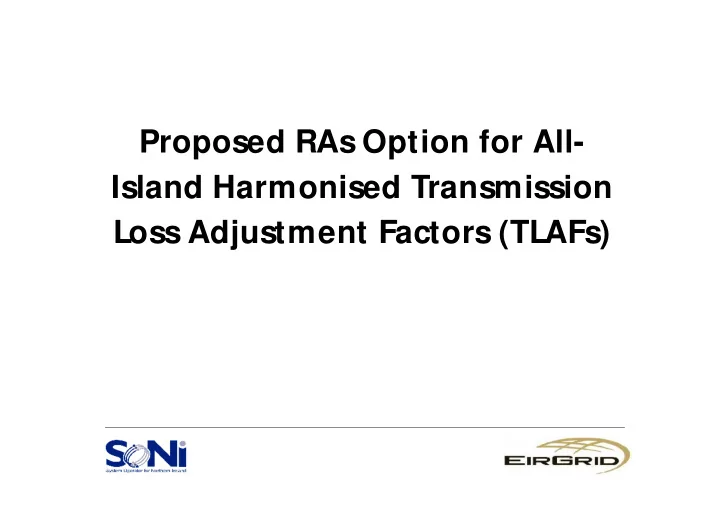

Proposed RAs Option for All- Island Harmonised Transmission Loss Adjustment Factors (TLAFs)
System Operator Presentations 1 . Current M ethodology – Pros & Cons 2. Responses to Preferred Options Paper 3. Studies into ULF and Impact on Constraints
1. Current TLAF M ethodology – Pros & Cons (Tim Hurley)
Outline of Presentation • Current M ethod – M ilestones • Current M ethod – Positive Aspects • Current M ethod – Common Issues
Current M ethod - M ilestones • In place ROI (2000) • SEM High Level Design (2005) • Consultation period (2006-2007) • In place SEM (2007) • Annual consultations
Current M ethod - Positive Aspects • Seeks Efficiency of Dispatch – Real time TLAFs most efficient • Aims to be Cost Reflective – Allocates, relative to location, more/ less losses
Current M ethod - Common Issues • Volatility • Predictability • Transparency • Ex ante (6 mths to 18 mths) • Compatibility with large scale intermittent generation • Based on current SEM /system design • Iterative dispatch
2. Responses to Preferred Options Paper (Helen M agorrian)
Introduction • Preferred Options Paper - published Nov ‘09 • Overview of Responses - published Jan ‘10 • 20 Industry Respondents on 3 outlined approaches 1. Compression 2. Splitting 3. Purchase of Losses
Compression • Little support for compression methodology – respondents suggested approach would result in : – Cross subsidisation – Increased regulatory risk – Inefficient dispatch – Diluted locational signal
Compression • Generators beside large demand centres with TLAF >0.98 were particularly anti compression • Generators with TLAF <0.98 were broadly supportive of any change from existing approach which could be demonstrated to provide real value added benefits. • Wind Farms were generally pro uniform loss factor
Splitting • Generally respondents expressed interest in this approach but requested greater detail on how this would be implemented • Concerns around the impact such changes would have on key mechanisms such as constraints, error supply unit, SM P etc. • Some respondents suggested that the proposal was not consistent with the principles of SEM
Purchase of Losses • Generally respondents were in favour of this option & suggested the focus should be on moving to this as an enduring solution rather than having a 3 step strategy of: 1. Compression – Short T erm Solution 2. Splitting – M edium T erm Solution 3. Purchase of losses – Long T erm Solution • Respondents felt the timeline for implementation was too long
Summary • SOs provided responses to RAs • Relatively little support for Compression as a Short Term Option • RAs published ‘Proposed Decision’ on 18 th June 2010 that losses be treated on a Uniform Basis
3. Studies into Calculation of Uniform Loss Factor and Impact on Constraints Costs (Louise Carolan)
Presentation Outline Following on from ‘Proposed Decision’ paper, RAs requested that the SOs examine: Average System Losses • SOs ran a number of Studies to Investigate Forecast – System Losses for 2010/ 11 Impact of a ULF on Constraints Costs • SOs examined the impacts on the Constraints Costs when – a ULF was used in place of a TLAF
Studies into Average System Losses
Studies into Average System Losses 1. PSSE Losses LookUp Table 2. Plexos Generation Forecast run through PSSE AC Load Flow Load Loss Factor M ethodology used for Validation –
1. PSSE Losses Look-up Table • No. of PSSE Study Cases at different demand levels – look up table • Forecast demand estimates generation for study period • Losses related to generation levels
2. Plexos Forecast Generation & AC Load Flow • Constraints Forecast M odel run through Plexos – Forecast of generation for the year (8,760 cases) • 8,760 Cases run through AC Load Flow • Output Losses for every Period • Average Losses as % of Sent Out Units
Load Loss Factor - Validation • Load Loss Factor (LLF) calculated based on total load and peak load: • LLF = (LF)k+(LF) 2 (1-k) • LLF used to validate calculated approximate annual losses
Results • Studies yielding approximately 2.0% Average System Losses
Considerations • Offset between PSSE Losses and Actual Losses – voltage profiles • Assumptions for the Constraints Forecast M odel based on a Locational Loss Factor M ethodology
Studies into Effects of ULF on Constraints Forecast
Constraints Costs • No systematic reason for impact on Constraints Forecast • Constraints Forecast may increase or decrease depending on circumstances at a point in time • Impact on Constraints Forecast inherently bounded by the Loss Factor Differentials
Study • Using SO models used for the Constraints Forecast Analysis, replaced TLAF with Uniform Loss Factor • SO model assumptions based on a Locational Loss Factor M ethodology • No increase in demand modelled
Results • Indicative Studies for 2010/ 2011 – Forecasting small increase in Constraints Costs – No systematic reason for increase
Thank Y ou
Recommend
More recommend